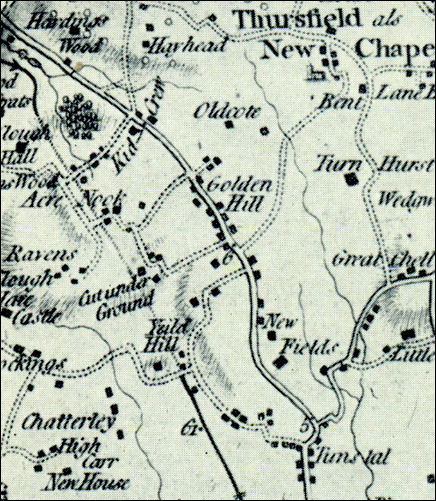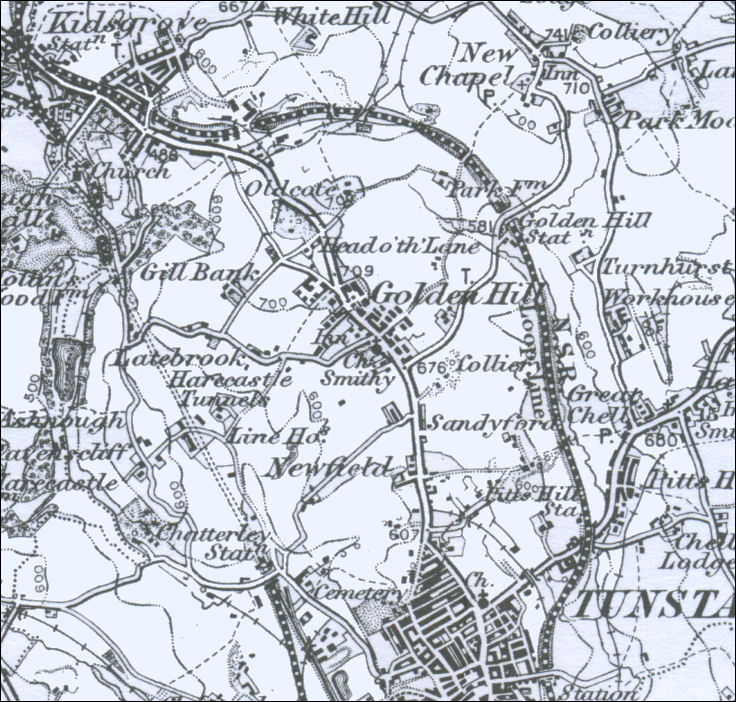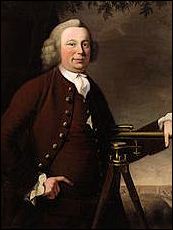|
Boathorse Road:
The Harecastle tunnel
- an essential part of the transport system to take raw materials
and finished ware to and from the Potteries - was built without a towpath.
Boats were propelled through the tunnel
without their ponies, who were walked over the top of the tunnel via Boathorse
Road.
In the
tunnel without the ponies, the barges used to be "legged" along.
This involved men lying on the top of the boat on their backs on
planks of wood with their legs hanging over the side of the boat,
and then literally "walking" on the stepped roof and sides of the
tunnel to propel the barge through.
There are two
Harecastle Tunnels, one of which is still in use today. The earlier
of the tunnels, built by Brindley, is now closed and disused. Yet
the Telford tunnel is used daily by canal boats coming to and from
the Potteries.
Brindley's Harecastle Tunnel took from 1766 to 1777 to
complete - eleven years in all - it took 600 miners and masons and
was built using a line of shafts that were dug across the length of
the tunnel, then these were joined together to form the tunnel. The
shafts dug ranged from 210 to 240 feet deep. Miners were lowered
down on ropes to dig, and the builders were fraught with many a
hazard, from bad air in the shafts, water ingress into the tunnel,
to quicksands, the build up of gasses from coal seams, to the
encounter of rock harder than anything that he had ever come across
before, such as granite and millstone grit. Many of the miners lost
their lives in the building process.
The tunnel was described by a writer in 1767 as "the eighth wonder
of the world …" as nothing like it had ever been attempted before..
The tunnel itself would run for some 2,897 yards and would join the
waterways between Kidsgrove and Tunstall. To give an idea of scale,
the next longest tunnel at that time was Preston Brook at 1,239
yards.
Needless to say, the tunnel is not very high - and not very wide
either. The Leggers would be workers who hung around the tunnel
entrance and would get paid for each boat they "legged" through the
tunnel. The speed they went at often depended on the "extra's" they
received for the work - it was mentioned that a slice of bread and
cheese could guarantee the help of a good legger who would happily
send a barge through the tunnel in the best time he could.
Due to the amount
of traffic and the slow process of legging, the Harecastle Tunnel
was becoming a major bottleneck on the canal. It was decided to
commission a second tunnel to be built by Thomas Telford. Due to
advances in engineering it took just 3 years to build and was
completed in 1827.
This second tunnel
had a towpath so that horses could pull the boats through the
tunnel. After its construction it was used in conjunction with the
Brindley tunnel with each tunnel taking traffic in opposite
directions.
The second Harecastle Tunnel was built by Thomas Telford.
Telford was a second generation engineer, who was born in
Dumfrieshire in 1757 and is noted for his founding of the Institute
of Civil Engineers and being their first President in 1820. His
achievements included the Menai Bridge, Anglesey in 1826 and the
Conway Suspension Bridge in 1826. A further achievement was the
Gotha Canal in Sweeden in 1832 amongst many others.
The second Harecastle Tunnel took from the sinking of 15 shafts, 237
feet deep at the most, then the laying of the first brick on 21
February 1825, to the laying of the last brick on 25 November 1826
to complete. There were cross tunnels to Brindley's old tunnel so
that it could be used for the removal of waste by barge from the new
tunnel whilst it was being built.
Telford is said to
have stated that although his tunnel a lot less time to build (3
years), he was unsurprised by the 11 years it took to build
Brindley's tunnel because of the hardness of the rock and the
problems experienced with water and gas. At that time, Telford
recommended that Brindleys tunnel be repaired and required vast
improvement. This recommendation was not carried out, much to the
later detriment of the Brindley tunnel which is now closed and in
total disrepair.
Golden Hill and the tunnel
in 1775:

Extract from William Yates
1775 Map of Staffordshire
Showing the few dwellings along a single track at Golden Hill
- click map for larger
area of map -
The Trent and Mersey canal is the black line
running from the bottom centre of the map - where the canal goes through the
Harecastle tunnel the map states "cut under Ground"

|
![]()

![]()
